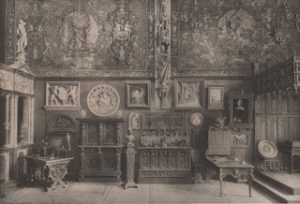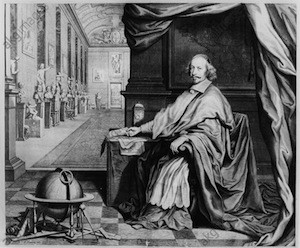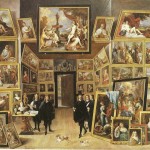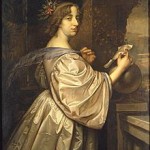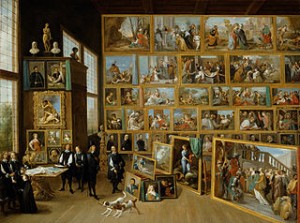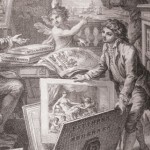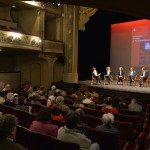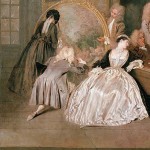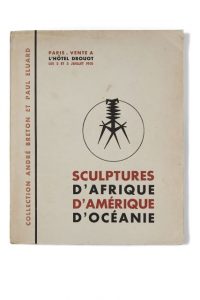 Le musée de Grenoble peut s’enorgueillir d’être le premier musée en France à avoir accepté dans les années 1920 une donation de deux objets en provenance d’Afrique (un masque Toma en 1923 et un masque Dan en 1929) grâce à l’action de son conservateur Pierre-André Farcy, dit Andry-Farcy (1882-1950), et de ses liens d’amitié avec le jeune collectionneur et marchand d’art Paul Guillaume (1891-1934). Farcy expose ces deux objets conjointement à des œuvres de Louis Marcoussis, Jean Lurçat et Marie Vassilieff dès le début des années 1930. Ainsi la marque de Paul Guillaume et des artistes d’avant-garde qu’il défendait s’imposait pour la première fois sur les cimaises d’un musée . . . → En lire plus
Le musée de Grenoble peut s’enorgueillir d’être le premier musée en France à avoir accepté dans les années 1920 une donation de deux objets en provenance d’Afrique (un masque Toma en 1923 et un masque Dan en 1929) grâce à l’action de son conservateur Pierre-André Farcy, dit Andry-Farcy (1882-1950), et de ses liens d’amitié avec le jeune collectionneur et marchand d’art Paul Guillaume (1891-1934). Farcy expose ces deux objets conjointement à des œuvres de Louis Marcoussis, Jean Lurçat et Marie Vassilieff dès le début des années 1930. Ainsi la marque de Paul Guillaume et des artistes d’avant-garde qu’il défendait s’imposait pour la première fois sur les cimaises d’un musée . . . → En lire plus
|
|||||
|
La prochaine séance du Séminaire Collection accueille : Francesco Montuori – Leiden University The Ataka Collection – Questioning Japanese Colonial Collecting. Laëtitia Lopes – University of East Anglia Collectionner le Vanuatu : le cas de la collection du gouverneur Louis Joseph Bouge. Réflexion sur la collecte et l’histoire coloniale au Vanuatu de la fin du 19e siècle au début du 20e siècle. 15 novembre 2022, en ligne sur Zoom, 18h30-20h00 La conférence, gratuite, aura lieu sur Zoom. Veillez à vous inscrire au préalable, afin de recevoir les informations nécessaire, à cette adresse : collection.seminaire@gmail.com
Deadline: Nov 30, 2022 Contributions are being sought for a peer-reviewed, English-language edited volume on the value of provenance in collecting and art market practices. This book, to be edited by Christian Huemer and Johannes Nathan, and to be published in the Brill series “Studies in the History of Collecting & Art Markets” will build on papers presented at the 5th Swiss Congress for Art History in Zurich earlier this year: https://www.vkks.ch/de/aktivitaeten/kongresse Abstract: Provenance information can significantly increase or diminish an artwork’s intrinsic and monetary value. While a “good” or “interesting” provenance is . . . → En lire plus « Edmond Foulc, Édouard André et Nélie Jacquemart : collectionneurs du XIXe siècle », 10 novembre 2020 (en ligne) En ligne, 18h30-20h00 Intervenantes : Giancarla Cilmi (EPHE) et Alexandra Gauthier (Paris 1 Panthéon-Sorbonne)
Les enjeux érudits du collectionnisme d’Edmond Foulc, bibliophile et collectionneur éclairé du XIXe siècle Edmond Foulc (1828-1916) est un membre reconnu du Cénacle des collectionneurs et bibliophiles français de la fin du XIXe siècle. Ce grand patron de l’industrie textile et tinctoriale, issu de la haute société protestante nîmoise, a favorisé la reconnaissance des arts décoratifs et architecturaux de la Renaissance européenne par la constitution d’une collection d’objets d’arts décoratifs et d’une bibliothèque . . . → En lire plus
We are inviting chapter abstracts for a collection of essays designed for academics, specialists, and enthusiasts interested in the interrelations between art and science in women’s collections and collecting practices beyond Europe in the long 18th century. This volume will follow our forthcoming compendium on the topic entitled, Women and the Art and Science of Collecting in Eighteenth-Century Europe, published by Routledge. This book recovers women’s histories through numerous interdisciplinary discourses pertaining to the subject of collecting, and it examines their interests, methodologies, . . . → En lire plus
Date limite : 05 avril 2020. 15 -16 juin 2020, salle Jullian (15 juin) et salle Vasari (16 juin), Institut National d’Histoire de l’Art (INHA) Pour clôturer cette année académique, le Groupe de Recherche en Histoire de l’Art Moderne (GRHAM) s’associe au Séminaire Collection pour l’organisation d’un colloque sur le thème du collectionnisme. Intitulé Collectionner : acteurs, lieux et valeur(s) (1750 – 1815), cet événement a comme objectif d’analyser les collectionneurs à travers leurs pratiques et leurs représentations, en insistant sur de nouvelles pistes de réflexions méthodologiques. Celles-ci permettront d’extraire cette thématique d’approches purement biographiques et monographiques. À partir de cas précis, le colloque entend appréhender le collectionnisme par le biais de problématiques et de méthodes . . . → En lire plus
Appel à communication en PDF : « La Vie intellectuelle en Aquitaine au temps de Montaigne » Deuxième journée : « Les bibliothèques et collections aquitaines » 15 octobre 2020 Depuis les années 1850, la bibliothèque de Montaigne n’a cessé de fasciner les chercheurs. En revanche, aujourd’hui encore peu de recherches sont menées sur le contexte du réseau des bibliothèques au sein duquel la librairie du philosophe a pris sa place. Ce réseau, au double sens géographique . . . → En lire plus How is art displayed within collections of different types: scientific, artistic, didactic, museological, private and public? Once we give access to it through this strategy of display, how is it understood? What kind of experience and/or knowledge does it promote? And how does that influence affect the writing of Art Histories? The physical spaces filled by these collections gather different experiences that need to be contemplated [taken into account] in the writing processes of Art Histories. Rather than evaluating works of art through the isolated images of each piece, their photographic representations and the data available in inventories, we propose that trying to access them in physical locations opens up new perspectives. Objects gain concreteness, materiality, positions, means of interaction with other pieces next to them as well as with people who relate to them under these circumstances, which enables us to take into consideration embodied acting observers. In certain locations, empty spaces acquire densities, as intervals between objects working as amalgamations of sense, contributing to give cohesion to the collections. We call for proposals that, within this mental framework, reflect about the spatiality of art collections, considering works of art as they occupy real physical spaces, instigating discussions about art and its location and the means of reception and understanding according to their means of display. . . . → En lire plus
Sandra Costa, professeur d’histoire de l’art à l’Alma Mater Studiorum de Bologne, Dominique Poulot, professeur d’histoire de l’art à Paris 1 Panthéon-Sorbonne, Mercedes Volait, directeur de recherche au CNRS. La table ronde sera modérée par Delphine Burlot, maître de conférences en histoire de l’art à Paris 1 Panthéon-Sorbonne. . . . → En lire plus Raffaello Sanzio da Urbino in the collections and in the history of collecting In view of the forthcoming 500th anniversary celebration of Raphael’s death (Raffaello Sanzio da Urbino, Urbino 1483 – Rome 1520), an international conference to focus on the reception of Raphael and the history of collections will draw together scholars of collecting and history of taste with curators of the main collections of Raphael’s paintings and drawings in both Italy and abroad. The conference, organised by Sybille Ebert-Schifferer and Claudia La Malfa, will be held at the Bibliotheca Hertziana – Max-Planck-Institut für Kunstgeschichte, in Rome in October 2017. Raphael’s works have enjoyed an uninterrupted fortuna in the history of collecting. His fame has fueled collectors’ passions for . . . → En lire plus
Dans une double perspective, celle de l’histoire et celle de l’histoire des arts (arts plastiques, musique, littérature), on y étudiera ses réseaux (diplomatiques, politiques, religieux, familiaux, de renseignement, les uns et les autres souvent mêlés), son collectionnisme, son mécénat, sa propagande (on attire l’attention sur la « correspondance politique » des archives des Affaires étrangères et son abondante documentation peu exploitée). Langues du colloque . . . → En lire plus
The University of Buckingham A one-year MA offered by the University of Buckingham and the National Gallery in association with Waddesdon Manor (Rothschild Collections). Investigating American and European art markets and cultures of collecting from the Renaissance to the present day, it is taught by staff from the University of Buckingham, the National Gallery and Waddesdon Manor. A unique MA A unique feature of the course will be access to two of the greatest surviving art dealers’ archives: Agnew’s, acquired by the National Gallery in 2014, and Colnaghi’s, housed since . . . → En lire plus
For more than a century, scholars from various disciplines have studied Queen Christina’s activities as patron and collector, in Rome as well as in Stockholm. The results have been published in a range of languages in diverse formats. What is lacking is a comprehensive overview of her collections and patronage in one publication and this conference aims to bring together some of the leading scholars in the field . . . → En lire plus
Curieux d’estampes. Collections et collectionneurs de gravures en Europe (1500-1815) Université Paris-Sorbonne Vendredi 24 octobre : Ecole du Louvre, Amphithéâtre Dürer, Palais du Louvre, Porte Jaujard Samedi 25 octobre : Site INHA (Institut National d’Histoire de l’Art), Salle Vasari, 2, rue Vivienne, 75002 Paris De nombreux historiens de l’art ont déjà eu l’occasion de traiter du thème des collections et des collectionneurs, depuis les études pionnières d’Antoine Schnapper, de Krzysztof Pomian ou encore de Francis Haskell, jusqu’à celles,plus récentes, de Michiel Plomp ou des contributeurs au colloque international, Collectionner, Collectionneurs au XIXe et XXe siècles, dirigé par Patrick Michel, Pauline Marcilhacy et Raphaël Abrille (Paris, musée de la Chasse et de la Nature, 2011). Pourtant, . . . → En lire plus
14 octobre 2014 – 18h30 Auditorium de la Galerie Colbert entrée libre Accès : 6 rue des Petits-Champs ou 2, rue Vivienne 75002 Paris Dorsimond est fou. Pour enrichir sa collection, il est prêt à tout sacrifier, même le bonheur de sa fille ! Mais l’amour est rusé et le collectionneur ne demande qu’à être trompé, pourvu qu’on lui assure que son cabinet de curiosités est le plus beau de Paris. Charles-Antoine Coypel (1694-1752) a hésité entre la carrière de peintre et de dramaturge. Avant de choisir définitivement le pinceau, il a écrit de nombreuses pièces, dont la plupart son restées inédites. La Bibliothèque centrale des musées nationaux a acquis un ensemble . . . → En lire plus
Brill’s « Studies in the History of Collecting & Art Markets » is a peer-reviewed book series dedicated to original scholarship on the social, cultural, and economic mechanisms underlying the circulation of art. Over the last two decades interest in the formation, display, and dissolution of art collections increased tremendously; art markets, trade routes, and dealer networks became a rich field of interdisciplinary inquiry. Scholarship brought forth a lot of information about the flamboyant personalities to whom the possession of art was a lifestyle; regarding the « social life of things », i.e. the provenance of individual artworks, many research gaps could be closed. This shift in scholarly attention . . . → En lire plus |
|||||


